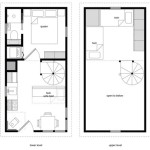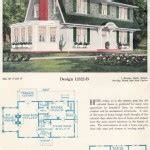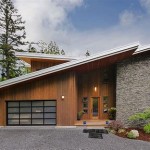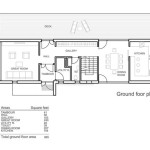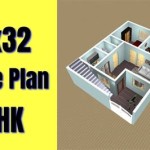A duplex house layout plan is a blueprint that outlines the design and arrangement of a duplex house. A duplex house is a two-family residential building that comprises two separate living units, typically side-by-side or one above the other. Each unit in a duplex house has its own entrance, kitchen, bathrooms, and living spaces, providing independent living quarters for two families or individuals.
Duplex house layout plans are crucial for guiding the construction and renovation of duplex houses. They ensure that the space is utilized efficiently, that the units are designed to meet specific needs and preferences, and that building codes and regulations are complied with. Architects and builders use these plans to create functional and aesthetically pleasing living spaces that meet the requirements of both occupants.
In the following sections, we will delve into the key considerations and elements of a duplex house layout plan, exploring the various types of duplexes, their advantages and disadvantages, and providing practical tips for designing an optimal layout.
The following eight important points should be considered when creating a duplex house layout plan:
- Number of bedrooms and bathrooms
- Kitchen layout and appliances
- Living room size and shape
- Laundry room location
- Storage space
- Outdoor space
- Energy efficiency
- Building codes and regulations
By carefully considering these factors, architects and builders can create duplex house layout plans that meet the specific needs and preferences of the occupants while ensuring compliance with building codes and regulations.
Number of bedrooms and bathrooms
The number of bedrooms and bathrooms in a duplex house layout plan is a crucial consideration that depends on the specific needs and preferences of the occupants. Here are some key points to consider when determining the optimal number of bedrooms and bathrooms:
**Number of occupants:** The number of bedrooms should correspond to the number of occupants in each unit. A typical duplex house layout plan includes two or three bedrooms per unit, providing ample space for families or individuals.
**Type of occupants:** The type of occupants can also influence the number of bedrooms required. For example, a duplex house with young children may require an additional bedroom to accommodate their growing needs.
**Master bedroom:** The master bedroom is typically the largest bedroom in the unit and includes an attached bathroom. Duplex house layout plans often incorporate a master bedroom in each unit to provide privacy and comfort.
**Guest room:** Some duplex house layout plans include an additional guest room to accommodate visitors or extended family members. This room can also serve as a home office or hobby room when not in use.
**Number of bathrooms:** The number of bathrooms in a duplex house layout plan is equally important. A minimum of one bathroom per unit is required, but many duplexes include two or more bathrooms for added convenience.
**Bathroom placement:** The placement of bathrooms should be carefully considered to ensure privacy and accessibility. Master bathrooms are typically located adjacent to the master bedroom, while secondary bathrooms are often shared between bedrooms.
**Half bathrooms:** Some duplex house layout plans include a half bathroom on the main floor for guests or to reduce bathroom traffic during peak hours.
By carefully considering the number and type of bedrooms and bathrooms, architects and builders can create duplex house layout plans that meet the specific needs and preferences of the occupants, ensuring comfortable and functional living spaces.
Kitchen layout and appliances
The kitchen is a central part of any home, and its layout and appliances play a crucial role in the functionality and comfort of a duplex house. Here are some key considerations and details related to kitchen layout and appliances in a duplex house layout plan:
Kitchen layout: The layout of the kitchen should be designed to maximize efficiency and functionality. Common kitchen layouts for duplex houses include:
- U-shaped kitchen: This layout features three walls of cabinetry and appliances, creating a horseshoe shape. It provides ample counter space and storage, making it ideal for families who cook frequently.
- L-shaped kitchen: This layout features two walls of cabinetry and appliances, forming an L-shape. It offers a good balance of counter space and storage, and is suitable for both small and large kitchens.
- Galley kitchen: This layout features two parallel walls of cabinetry and appliances, creating a narrow walkway in between. It is space-efficient and ideal for smaller duplex units.
Appliances: The choice of appliances for a duplex house kitchen depends on the needs and preferences of the occupants. Standard appliances typically include:
- Refrigerator: A refrigerator is essential for storing perishable food items. Duplex houses often have two refrigerators, one for each unit.
- Stove and oven: A stove and oven are used for cooking. Gas or electric stoves are common choices.
- Microwave: A microwave is a convenient appliance for quickly heating food.
- Dishwasher: A dishwasher saves time and effort by cleaning dishes automatically.
Other considerations: In addition to layout and appliances, other considerations for the kitchen in a duplex house layout plan include:
- Counter space: Ample counter space is essential for meal preparation and other kitchen tasks.
- Storage space: Sufficient storage space is necessary for cookware, utensils, and other kitchen items.
- Lighting: Adequate lighting is important for visibility and safety in the kitchen.
- Ventilation: Proper ventilation is crucial to remove cooking odors and fumes.
By carefully considering these factors, architects and builders can create duplex house layout plans with kitchens that are both functional and aesthetically pleasing, meeting the specific needs and preferences of the occupants.
Living room size and shape
The size and shape of the living room in a duplex house layout plan have a significant impact on the overall functionality and comfort of the unit. Here are some key considerations and points to remember when designing the living room:
- Size: The size of the living room should be proportionate to the overall size of the unit and the number of occupants. A larger living room provides more space for furniture, activities, and entertaining guests, while a smaller living room may be more cozy and intimate.
- Shape: The shape of the living room can influence furniture placement and traffic flow. A rectangular living room is the most common shape and offers flexibility in furniture arrangement. A square living room is also a good option, providing a more balanced and symmetrical space. Irregularly shaped living rooms can be more challenging to design but can also create unique and interesting spaces.
- Furniture arrangement: The furniture arrangement should be carefully planned to maximize space and create a comfortable and inviting atmosphere. Common furniture arrangements include placing a sofa and chairs around a coffee table, or arranging furniture in conversation groups to encourage interaction.
- Natural light: Natural light can make a living room feel more spacious and inviting. Large windows or sliding glass doors can bring in ample natural light and provide views of the outdoors. Skylights can also be used to supplement natural light in living rooms that lack windows on multiple walls.
By carefully considering the size, shape, furniture arrangement, and natural light in the living room, architects and builders can create duplex house layout plans with living rooms that are both functional and aesthetically pleasing, meeting the specific needs and preferences of the occupants.
Laundry room location
The location of the laundry room in a duplex house layout plan is an important consideration that affects both functionality and convenience. Here are some key points and details to remember when determining the optimal location for the laundry room:
- Central location: A central location for the laundry room is ideal, as it provides easy access for both units. This can be achieved by placing the laundry room in a common area, such as the basement or a hallway that connects the two units.
- Proximity to bedrooms: The laundry room should be located in close proximity to the bedrooms, as this is where most of the laundry is generated. This can help to minimize the distance that occupants have to carry laundry baskets.
- Ventilation: The laundry room should have adequate ventilation to remove moisture and prevent mold and mildew growth. This can be achieved by installing an exhaust fan or by providing a window that can be opened.
- Space: The laundry room should be large enough to accommodate a washer and dryer, as well as other laundry-related items such as a laundry basket, ironing board, and detergent. If space is limited, a stackable washer and dryer can be used to save space.
By carefully considering these factors, architects and builders can create duplex house layout plans with laundry rooms that are both functional and convenient, meeting the specific needs and preferences of the occupants.
Storage space
Adequate storage space is essential in any home, and a duplex house layout plan should carefully consider the storage needs of both units. Here are some key points and details to remember when planning for storage space in a duplex house:
- Closets: Closets are a staple storage solution in bedrooms and hallways. They provide a convenient place to store clothes, shoes, and other personal belongings. Duplex house layout plans should include ample closet space in each unit, with a mix of reach-in closets and walk-in closets to accommodate different storage needs.
- Cabinets: Cabinets offer both storage and display space in kitchens, bathrooms, and other areas of the house. Duplex house layout plans should incorporate a sufficient number of cabinets in each unit to provide storage for cookware, dishes, toiletries, and other household items. Kitchen cabinets should be designed to maximize storage space and functionality, with features such as pull-out shelves and lazy Susans.
- Pantries: Pantries are dedicated storage spaces for food and non-perishable items. Duplex house layout plans should include a pantry in each unit to provide ample storage space for groceries, snacks, and other food items. Pantries can be located in the kitchen, laundry room, or a separate storage area.
- Attic and basement: If the duplex house has an attic or basement, these spaces can be utilized for additional storage. Attic storage can be accessed via a pull-down ladder or stairs, while basement storage can be accessed through a door or bulkhead. Duplex house layout plans should consider the potential for attic and basement storage and incorporate access points and lighting into the design.
By carefully considering these storage needs, architects and builders can create duplex house layout plans that provide ample and functional storage space for both units, ensuring that occupants have a place for everything and everything has a place.
Outdoor space
Outdoor space is a valuable asset for any home, and duplex house layout plans should carefully consider the incorporation of outdoor living areas. Here are some key points and details to remember when planning for outdoor space in a duplex house:
Patios and decks: Patios and decks are popular outdoor living spaces that provide a place to relax, entertain guests, and enjoy the outdoors. Duplex house layout plans can incorporate patios or decks off the living room or kitchen area, creating a seamless transition between indoor and outdoor living. Patios can be constructed of concrete, pavers, or other durable materials, while decks are typically made of wood or composite materials.
Yards and gardens: Yards and gardens offer more extensive outdoor space for activities such as gardening, playing, and entertaining. Duplex house layout plans can include private yards for each unit, or a shared yard that is accessible to both units. Yards can be landscaped with grass, trees, shrubs, and flowers to create a beautiful and inviting outdoor space.
Balconies: Balconies are elevated outdoor spaces that can be incorporated into duplex house layout plans to provide additional outdoor living space, especially in urban areas where land is limited. Balconies can be accessed from bedrooms or living rooms, and can offer views of the surrounding area. They can be constructed of wood, metal, or concrete, and can be designed with railings or screens for safety and privacy.
Common outdoor areas: In addition to private outdoor spaces for each unit, duplex house layout plans can also include common outdoor areas that are shared by both units. These areas can include a pool, barbecue area, or fire pit, and can provide a space for socializing and community building among the occupants.
By carefully considering these outdoor space needs, architects and builders can create duplex house layout plans that provide functional and inviting outdoor living areas for both units, enhancing the overall livability and enjoyment of the home.
Energy efficiency
Energy efficiency is a crucial consideration in modern duplex house layout plans. By incorporating energy-efficient features and design strategies, architects and builders can create homes that consume less energy, reduce operating costs, and minimize environmental impact.
One key aspect of energy efficiency is the building envelope, which includes the walls, roof, windows, and doors. By using high-performance insulation and air sealing techniques, the building envelope can be made more resistant to heat transfer, reducing the amount of energy required to maintain a comfortable indoor temperature.
Another important element is the heating, ventilation, and air conditioning (HVAC) system. Energy-efficient HVAC systems use advanced technologies to reduce energy consumption, such as variable-speed fans, programmable thermostats, and heat recovery ventilators. These systems can be integrated with smart home controls to further optimize energy usage.
In addition to the building envelope and HVAC system, other energy-efficient features can be incorporated into duplex house layout plans. These include energy-efficient appliances, LED lighting, and solar panels. Energy-efficient appliances use less energy to perform the same tasks as traditional appliances, while LED lighting consumes significantly less energy than incandescent or fluorescent lighting.
By carefully considering these energy-efficient measures, architects and builders can create duplex house layout plans that meet the highest standards of energy efficiency, resulting in lower operating costs, enhanced comfort, and a reduced environmental footprint.
Building codes and regulations
Building codes and regulations are essential guidelines that govern the design and construction of duplex houses. These codes and regulations are established by local authorities to ensure the safety, structural integrity, and habitability of buildings. They cover a wide range of aspects related to duplex house layout plans, including:
Zoning: Zoning laws determine the types of buildings that are permitted in specific areas. They may restrict the height, size, and density of duplex houses in a particular neighborhood. Architects and builders must carefully review the zoning regulations for the intended location of the duplex house to ensure compliance.
Building codes: Building codes specify the minimum standards for the construction of buildings. They cover aspects such as structural design, fire safety, plumbing, electrical systems, and energy efficiency. Duplex house layout plans must adhere to these codes to ensure the safety and functionality of the building.
Fire codes: Fire codes are designed to minimize the risk of fire and protect occupants in the event of a fire. They specify requirements for fire-resistant materials, smoke detectors, fire alarms, and emergency exits. Duplex house layout plans must incorporate features that comply with fire codes to ensure the safety of the occupants.
Accessibility codes: Accessibility codes ensure that buildings are accessible to people with disabilities. They specify requirements for ramps, elevators, wider doorways, and accessible bathrooms. Duplex house layout plans must incorporate accessible features to comply with these codes and provide equal access to all occupants.
By adhering to building codes and regulations, architects and builders can create duplex house layout plans that are safe, functional, and compliant with the law. This helps to protect the health and well-being of occupants, ensures the structural integrity of the building, and maintains the value of the property.










Related Posts




